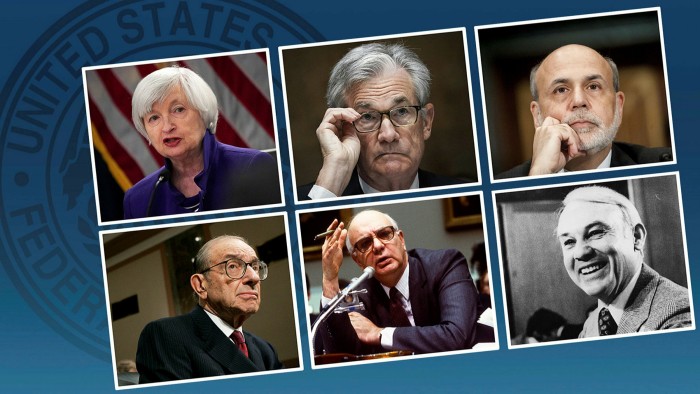The real bond kings and queens sit on the Federal Reserve throne

Roula Khalaf, Editor of the FT, selects her favourite stories in this weekly newsletter.
The writer is a philanthropist and co-founder of Pimco. He was also fund manager at Janus Henderson Investors from 2014 until his retirement in 2019
Let me be honest. The only bond kings and queens over the past half-century since credit was unleashed from its gold standard in the early 1970s have been the US Federal Reserve chairs.
Sure, there were lauded economists Henry Kaufman and Albert Wojnilower during the frantic end days of double-digit inflation in the early 1980s but they were consiglieres egging on clients to avoid long bonds and then somewhat belatedly issuing an all-clear.
There never has been an investor that could move bond markets with a large enough wallet to make a difference. The Fed chair with the ammunition of the global currency has been sitting on the monetary throne for the past 50 years.
And now it is Jay Powell — well meaning I’m sure, but bombarded with unique pandemic-related circumstances that make me wonder whether he has changed his conservative clothes and unleashed the potential for chaotic future economic and market outcomes.
Granted, he is conjoined now more than ever with the Treasury and forced to accommodate peacetime deficits of unimaginable size. That these fiscal and monetary monarchs have logical intentions is not in doubt — a return to a pre-coronavirus economy of 3 per cent real growth and 2 per cent inflation is their goal. Still, how does Powell (and Washington) get there, and for how long do they keep their “pedal to the metal”?
I suspect that $5tn spending programmes and the Fed’s current package of near zero per cent short-term rates and $120bn of monthly bond buying will move growth, inflation and financial markets far beyond reasonable targets that ultimately will jeopardise post-Covid-19 normals.
Even enthusiasts of the Fed’s policy must wonder whether hundreds of cryptocurrencies or a boom in special purpose acquisition vehicles are the result of continuing financial innovation or the product of cheap and plentiful credit demanded by deficit spending and an accommodating Fed chair.
Powell will not even acknowledge asking the question about asking the question until Covid is more under control and employment returns to historical norms. Yet unemployment may never return to 4 per cent, given the radical changes in working from home and Zoom-like technological shifts.
What is Powell’s new Nairu? The Fed’s historical model for the “non-accelerating inflation rate of unemployment” cannot be a reliable guide for future policy rate changes. And how long can the Treasury continue to require near-costless Fed financing for $2tn, $3tn and $4tn deficits without sinking the dollar? In a historical gold-standard world, Fort Knox would have been emptied long ago, implying the bankruptcy of the world’s reserve currency.
Many observers wonder how Treasuries and other global sovereigns can trade at yields that are so low, and in some cases negative.
Five-year US Treasuries currently yield just 0.80 per cent, not much in a world where inflation expectations over the same period are above 2.5 per cent. That is reflected in the negative real yields, which have the effects of inflation stripped out. Five-year US inflation protected bonds now trade at a yield close to minus 2 per cent.
Part of the explanation lies with the less attractive yield on local sovereign debt for foreign institutions (minus 0.5 per cent in Germany, for instance).
Even US investors, however, believe that a 10-year Treasury yielding 1.65 per cent can earn a total return of 2.40 per cent or more by capturing the rising price of the bond as it approaches its maturity date. And then there’s the Fed buying more than $1tn Treasuries a year. No wonder the 10-year Treasury rests illegitimately at 1.65 per cent.
Such speculations, however, are dependent upon the stability of the dollar and the consistency of Powell’s vow to keep short rates unchanged for the foreseeable future. At some point in the next few months, hopes for this will probably be disappointed as inflationary pressures pose increasing price risks to Treasuries and stocks too.
The Fed cannot for long continue to maintain current policy rates and expand its own balance sheet and therefore private bank reserves at a $120bn monthly pace.
Ten-year Treasuries morphed into the “risk” asset category several years ago. Stocks with valuations supported by low yields have entered the same category now, no matter the growth potential for 2021 and 2022. Cash has been trash for years but soon it may be the only haven for investors sated beyond reasonable expectations of perpetually low yields and supportive bond kings and queens.
Unhedged — Markets, finance and strong opinion
Robert Armstrong dissects the most important market trends and discusses how Wall Street’s best minds respond to them. Sign up here to get the newsletter sent straight to your inbox every weekday
Comments